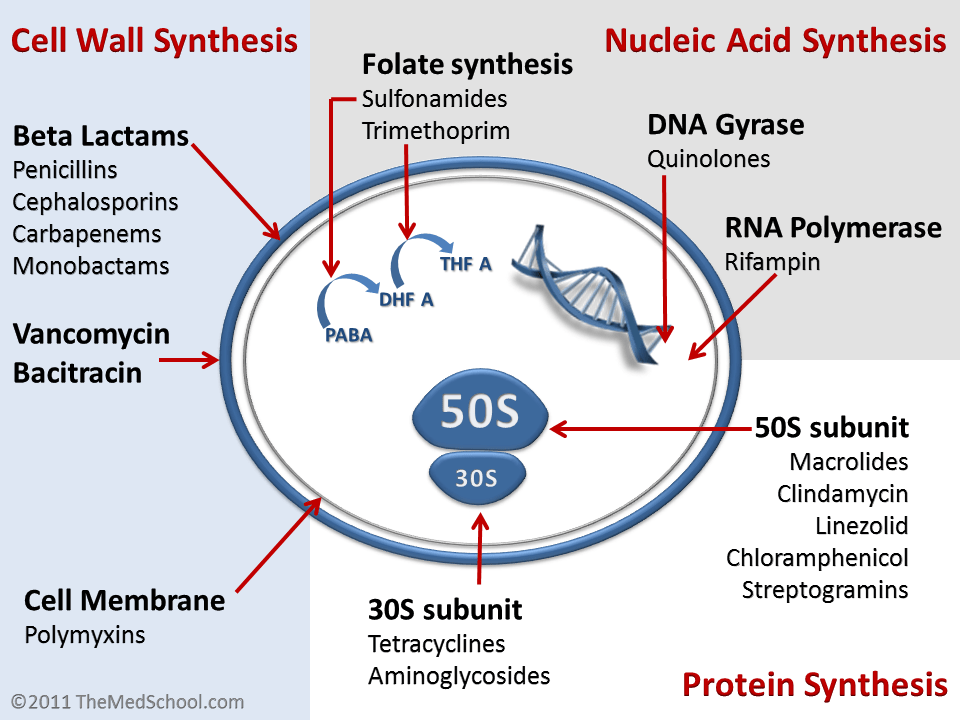Antibiotics may be bactericidal or bacteriostatic.
These drugs kill bacteria. They are used in special situations like life threatening infections, immunocompromised host and endocarditis.
These drugs inhibit the growth of bacteria without killing them so that the bacteria can grow once the antibiotic is removed. We rely on our host defense mechanisms to work in conjunction with the bacteriostatic drug to effectively kill the bacteria. Because of that, bacteriostatic drugs are ineffective in an immunocompromised host.
This group includes Beta Lactam antibiotics, Vancomycin, Cycloserine and Bacitracin.
Penicillin is effective only in growing cells hence it acts when bacteria are in the log phase of cell growth.
The beta lactam ring of Penicillin mimics the D- alanine D- alanine portion of peptide chains in the cell wall that is normally bound by Penicillin Binding Protein (PBP). The PBP interacts with the beta lactam ring and hence cannot be used any longer for peptidoglycan synthesis in the cell wall. Some of these PBPs are transpeptidases which cross link the peptidoglycans in the cell wall. Penicillin inhibits these transpeptidases. Apart from that, other enzymes called murein hydrolases are activated in Penicillin treated cells which degrade the peptidoglycan and cause cell lysis.
Although Penicillins are bactericidal against gram positive cocci, gram positive bacilli, Neisseria, Treponema pallidum and anaerobes (except Bacteroides fragilis) they are less effective against gram negative bacilli. This is because they can only poorly penetrate the outer membrane of gram negative microbes. Some exceptions are modified Penicillins like Ampicillin and Amoxicillin which can act on gram negatives like Haemophilus influenzae, E coli, Proteus, Salmonella and Shigella; Ticarcillin and Piperacillin which are active against Pseudomonas and Nafcillin and Dicloxacillin which are effective against Penicillinase producing S. aureus.
Mechanism of action is very similar to Penicillin in that they inhibit cell wall synthesis by interacting with PBPs as above. The first generation cephalosporins are primarily active against gram positive cocci while the newer cephalosporins have a successively broader coverage against both gram positive and gram negative bacteria. They can be substituted for Penicillin in patients who are hypersensitive to Penicillin but they are not used in patients who show anaphylaxis to Penicillins.
These are Vancomycin, Teicoplanin, Telavancin, Ramoplanin and Decaplanin. They bind directly to D- Alanine D- Alanine portion of the precursor peptidoglycan cell wall and thus blocking the transpeptidase from binding. This inhibits cell wall synthesis.
Vancomycin is the drug of choice for MRSA (Methicillin resistant S.aureus). It is effective against gram positive bacteria, Staphylococci and Enterococci. Teicoplanin has a similar range of efficacy.
They are Imipenem, Meropenem, Doripenem and Ertapenem. They are broad spectrum bactericidal antibiotics effective against both gram positive and gram negative bacteria as well as anaerobes. Imipenem is the drug of choice for Extended Spectrum Beta Lactamase (ESBL) producing gram negative bacilli.
Carbapenems bind to PBPs and thus inhibit bacterial cell wall synthesis.
Aztreonam, Tigemonam, Nocardicin A and Tabtoxin are included in this group. Mechanism of action is like all beta lactam antibiotics. They are effective against aerobic gram negative bacteria only.
Cycloserine/ Seromycin is used as a second line drug for Tuberculosis. It is structurally similar to D Alanine which is used to build D-Alanine D-Alanine in the bacterial cell wall. Because of the same reason Cycloserine inhibits enzymes alanine racemase and D-Alanine D-Alanine ligase. That’s how Cycloserine inhibits cell wall synthesis.
Bacitracin: It is used topically to treat skin infections. Bacitracin inhibits dephosphorylation of lipid carriers that transport peptidoglycan subunits across the cell membrane thus inhibiting cell wall synthesis.

Sign up for free to take 1 quiz question on this topic